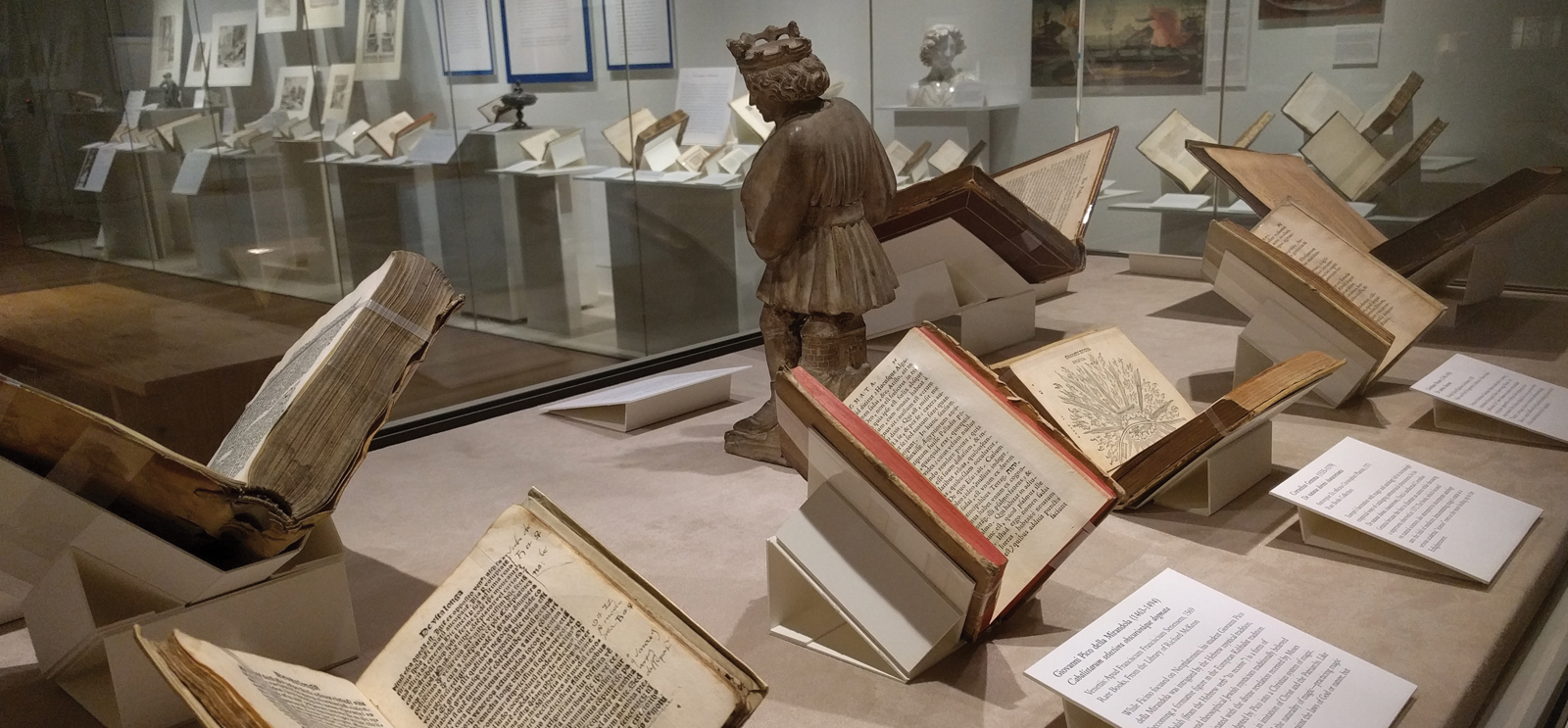
An exhibit on the occult includes books about magic, which contain notes from the people who used them. (Special Collections Research Center)
What do Mexico City, Platonic magic, and Yiddish epic poetry have in common?
When you walk into the exhibit Tensions in Renaissance Cities, the first display case you see is on Mexico City.
At the time Mexico City was known as the “Rome and Athens of the New World,” according to postdoctoral fellow Stuart McManus, who curated the Mexico City case.
“It’s meant to surprise people,” says Ada Palmer, assistant professor of history. During the colonial period, “Latin humanism and excitement about antiquity,” as she describes the Renaissance, spread as far as the New World and Japan. In Spanish-controlled Central America, Jesuit schools taught students Latin. The students then wrote Latin orations celebrating Central American antiquity: “The language of power for colonial oppressors is also a language of power for colonized peoples,” she says.
The exhibit, which runs through June 9, coincides with the annual conference of the Renaissance Society of America, held in Chicago this year. Palmer invited graduate students in a range of disciplines—history, art history, English, the Committee on Social Thought, Middle Eastern studies, Romance languages, history of science—to participate. Fifteen grad students contributed, including Stuart McManus, a postdoc at the Stevanovich Institute on the Formation of Knowledge, who curated the Mexico City case.

While Florence wavered between the secular and the sacred, the small city-state identified with David, the boy who defeated a giant. This modern terra cotta bust is a copy of the 15th-century bronze sculpture by Florentine artist Vercocchio.
Palmer originally suggested an exhibit showcasing Renaissance treasures of the library; her cocurators, Hilary Barker, AM’16, and Margo Weitzman, AM’15, came up with the theme of cities. As well as Mexico City, the exhibit looks at Florence, Rome, Venice, Constantinople, London, Geneva, Paris, and Nuremberg. Its curators borrowed a number of Renaissance sculptures and paintings from the Smart Museum of Art, in addition to Special Collections’ holdings.
Another surprise of the exhibit is that it portrays the Renaissance as dangerous, even desperate. The Renaissance is “a period we romanticize,” says Palmer. “Our Renaissance is cathedrals and Raphaels and Michelangelos. And that’s all true, but the average life expectancy in Renaissance Florence was 18”—far below what it was in the so-called Dark Ages. There was more disease, more war, more urban violence: “The actual lived experience was much worse.” So the obsession with classical antiquity during the Renaissance was driven, says Palmer, by a longing for “an impossible golden age of peace—a time when a traveler could go from England to Turkey on safe roads.”
The largest section of the exhibit focuses on Florence and Rome—the tensions within and between them. The two cities “are both the birthplace and the cultural capital of this obsession with Roman antiquity,” says Palmer.
As cities across Europe and beyond attempted to define themselves as the “new Rome,” Rome itself struggled. Population is a useful lens here, Palmer says. During the Renaissance there were five major cities: Milan, Florence, and Naples with 100,000 people each; Paris with 250,000; and Constantinople (before it was conquered and decimated by the Turks) with 500,000.

The exhibit contrasts the lesser-known violence and disease of the period with its artistic and scientific advances. A 17th-century work by Venetian astronomer Giovanni Paolo Gallucci, for example, showed astronomical rituals, or wheels used as nautical navigational tools.
Rome had just 20,000 people, living in a city built for one million. Its population had never recovered from the sack of Rome in 410 AD and the Justinian plague a century later. “It’s a hollow doughnut city,” says Palmer, “with sheep grazing in the Forum and a small population clustered at the edges, around the Vatican and other Christian pilgrim sites.” Rome was now a cultural and economic backwater, and yet remained “absolutely giant politically,” with a pope who could disrupt politics anywhere in Europe. Rome wanted to celebrate its ancient greatness, but that pagan legacy clashed with its newer claim as the capital of Christianity. “It’s a very tense city identity.”
Nearby Florence had a flourishing economy, trade contacts all over Europe, and was the birthplace of the classical revival. But was it trying to be the new Rome or the new Athens? Florence was home to Girolamo Savonarola, a preacher who prophesied that Florence was God’s chosen city, where the church would be reformed against Roman corruption. It was also home to Marsilio Ficino, who conducted Platonic magic experiments, of which the church took a dim view. “There’s a deep tension there,” says Palmer. “How can Florence have these two identities at once?”
One entire display case in the exhibit is dedicated to magic and the occult in Florence—including books on magic with marginalia added by the people who attempted to use them. Another case features volvelles, paper constructions with moveable parts, which could be used to show the movement of the planets, for example.
Yet another case is on pasquinades, anonymous satirical poetry about the pope or the government, which was stuck to the ancient Roman statue of Pasquino, aping handwritten newsletters issued by the papacy that were posted in the same square. “To this day people still do it,” says Palmer. “It was the premodern version of Twitter.” In the catalog for the exhibit, a selection of these short poems is laid out like a Twitter feed.
There’s a case on Jewish humanist scholar Elia Levita, who wrote Yiddish epic poetry as well as scholarly work in Hebrew (and allegedly is an ancestor of former British prime minister David Cameron). It’s one more twist in an exhibit full of the unexpected. “I’ve never gone into Special Collections and not been surprised,” says Palmer. “That’s the point of exhibits.”
